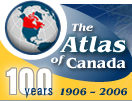| Health- and education-related activities now dominate
the public sector, accounting for three-quarters of all public-sector
jobs. Not surprisingly, health and education employment specialization
have become important components of any local economy and of its
social well-being. In many places, universities, community colleges
and regional health centres are among the largest employers and
service providers.
 [D] [D]
Click for more information, 25 KB
Photograph of University of Toronto
Geographical Description
This map is composed of three thematic map layers that show health
and education specialization in terms of overall health and education
employment activity (initial map view) and individually for health
and education. On all map layers, the size of the circles is proportional
to the population of the cities, while the degree of specialization
is shown by the colour in the legend.
Although not as irregularly distributed as jobs in public administration,
employment in health and education tends to be distributed irregularly
because the single employer - typically a branch of the provincial
government - may concentrate facilities in hopes of achieving economies
of scale. While there are university towns and small regional centres
with large health-care facilities, education and health activities
generally tend to choose the same market centres that are selected
by commercial activities.
Employment in education includes primary and secondary education,
which are closely related to the population of the market, and post-secondary
education, which is more erratically located and therefore largely
accounts for the spatial concentration of specialization in education.
For the most part, both components of education are funded and allocated
by the provincial governments. A number of regional centres with
universities emerge as being specialized in education. They include
Prince George, British Columbia; Lethbridge, Alberta; Brandon, Manitoba;
Guelph and Kingston, Ontario; Sherbrooke, Quebec; and Fredericton,
New Brunswick. In general, the industrial cities of southern Ontario
and Quebec are less favoured, especially those places that lie in
the shadow of larger cities. Rural and urban differences in educational
specialization are very strong, and there are major variations among
the urban centres surrounding the larger metropolitan regions such
as Toronto and Montréal: some attract higher education, while
others are largely residential.
Although health-care employment is partly funded by the federal
government, the provincial governments largely determine the location
of facilities. Like education, health-care facilities operate at
two levels: doctors, clinics and local hospital facilities are closely
related to the market, but regional facilities (for example, for
the mentally ill) lead to specialized health-care centres. Health-care
specialization is distributed in much the same way as commercial
services. Health-care facilities in smaller cities provide services
for residents of the nearby trade areas. At the same time, the growing
importance of health care has led to specialized regional centres,
such as Kenora, Ontario; Portage la Prairie, Manitoba; Joliette,
Quebec; and Gander, Newfoundland and Labrador. In general, the industrial
cities of southern Ontario and Quebec are less favoured, especially
those places that lie in the shadow of larger cities. A more serious
problem is the relative lack of facilities in some of the most isolated
locations (for example, Kitimat, British Columbia; Labrador City,
Newfoundland and Labrador; Wood Buffalo, Alberta; and Quesnel, British
Columbia).
To properly interpret this map, please consult the text Data
and Mapping Notes.
|
